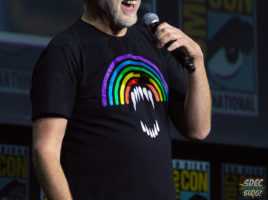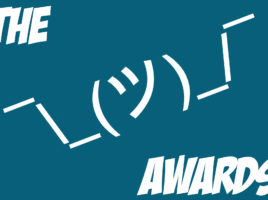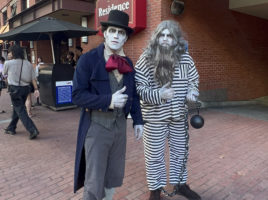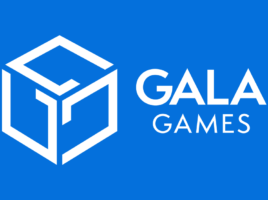SDCCBlog.com reader Tyler Miller sent us a firsthand account on how he went about planning and hosting his SDCC panel, geekEd: Bringing Geek Back to Higher Education, at Comic-Con 2011. Interested in what it takes to pull off a successful panel? Read on.
It was Comic-Con 2010. My first. Overwhelming to say the least as my wife and two kids (5 months and almost 3) navigated our way through the exhibits, went to panels, and had a blast. Since 1990, it was a dream for me to attend comic-con and I was living out a dream to be in attendance at the Con.
My friend and colleague Ryan let me know that Comic-Con was reaching out to college educators. I registered my family for tickets and we were ready to go! During the Con, we took Ryan out to dinner to thank him for helping us go to Comic-Con. As we sat at dinner that Thursday evening at Comic-Con 2010, we looked at each other and knew. We could TOTALLY present at Comic-Con. We could talk about higher education and geekdom. We knew it was possible as we’ve presented at conferences before. Both of us had won awards for presentations given in our own field at our regional conference. My wife came up with the name – “what about geekEd. ?” It was a play on “geeked” but was a blending of our passions – higher education and geek life. Then and there, Ryan and I agreed that we would put in the proposal when it came out to present at Comic-Con 2011.
In January, the forms for professional registration came out. We read through it, and I saw the program form. I filled it out, and asked two other colleagues to join our panel team. I knew they had been to Comic-Con in the past, and at the time I am sure they thought we would have no chance of being selected for a Comic-Con panel. They agreed and connected me with someone I didn’t know who was a colleague of theirs who had been to 13 comic-cons previously, Alfred.
We knew our topic – how do you use your “geekness” to succeed in Higher Education. From a staff perspective, student perspective, etc. “Geek Week Programming.” The UC Santa Cruz “Social Fiction Conference.” Free Magic Cards for college students from Wizards of the Coast marketing/distribution. But most of all, I knew they (CCI) were reaching out to us – and I submitted a cover letter saying we wanted to give back – which we did. We also had a diverse panel – 5 different higher educational institutions represented, I had all the confidence in the world we could present at Comic-Con – I just wondered whether we’d get the chance. People in the know suggested we start at Wonder-Con. I felt like Comic-Con was the place for us and submitted the proposal in January. I knew it was a long shot, but still, I thought we had a good chance.
I didn’t hear a thing for six months. And then, the email came the first week of June. We had been selected, and we were presenting Friday night at 8pm. I was in shock, and as I forwarded the confirmation to our panel, we were all in disbelief. Less than two months to plan and we had questions. Only three members of our five panel team currently had registration for SDCC 2011. Would our other panelists be given registration passes? We had no money – how would we market the panel? What to do?
I emailed the SDCC blog with questions. I emailed the program person with questions. I emailed people I knew who had comic-con experience questions. And I got helpful answers. Here is what we did/learned/would do differently:
First, Logistics:
- If you are selected to present at Comic-Con, you are given full four day badges for your panelists. Each Panelist can bring a guest for free with them. Kids under 12 are also free and do not count toward your quota. You are also allowed to purchase additional tickets for assistants and such
- Lodging. This is not covered. Fortunately, one of our colleagues worked at CSU San Marcos and they were willing to house us on Campus. This was a huge benefit.
- Parking. This is also not covered. If you are thinking about putting together a panel, you may want to get parking passes for each day of the conference in advance. You won’t know which day you will be placed on. For us, to give us the best chance of being selected, we let the program committee know we were willing to present whenever they’d like us to.
- Video taping: We were allowed a videographer badge in addition to the badges for panelists and guests. We were responsible for our own audio/visual equipment as well.
Second, Marketing
- We set up a facebook page and a twitter account. One issue we ran into is people wanted to know a website connected to our twitter page. We linked ourselves to one of the blogs written by one of the panelists.
- We created a logo. Fortunately, I have some experience in marketing and we worked to make something simple, yet visual.
- We designed a press release. People may not know this, but you can ask for a list of all the press attending comic-con about 3 weeks prior to the conference. We sent an email blast to all the press listed, with our cool logo and what our panel was about.
- We immediately got a few requests for interviews. If you are able, you may want to have someone to coordinate the interviews. Being the panel coordinator, on the panel, and the person coordinating the interviews was a LOT of work.
- We tried our best to set up times for interviews prior to the conference. Some worked and some didn’t. One problem we ran into was figuring out location to hold the interviews. The industry lounge will not allow press into the room, which worked against what we thought would happen.
- We created marketing materials to hand out during the conference. While we were in line, on the exhibits floor, etc. We made cheap buttons – one of our panelists had access to a button maker and made about 150 buttons with our logo and various sayings like “Buffy Slayed Vampires in College” or “Even Superman went to College.” We also made half sheet post card flyers to hand out.
- We searched for someone to sponsor t-shirts and SWAG. I will have a separate section on SWAG in a bit, because we got REALLY lucky with SWAG. Ultimately, one of our panelists’ host institution paid for 50 t-shirts at $5 a piece. This was a huge thing.
- Finally, we emailed all sorts of folks to try and develop interest in our panel. Put our name out on twitter, blogs, etc. We didn’t want to be “skeevy” so we tried to do this as naturally as we could.
Third, SWAG
- Being that we were college educators, we had a lot of access to SWAG. We got lucky because our panel was the last one of the night, and there was no pressure to get us out of the room. We put down in our registration in January that we wanted to hand out swag, but no one contacted us about it. My recommendation would be to contact the program committee a week or two prior to make sure SWAG distribution is taken care of.
- We had a “helper” handing out t-shirts to people who asked questions and at the end of the panel, they started handing out various SWAG to audience members. This made for a very organic panel, but probably wouldn’t be repeatable in the future (especially if there was a panel coming in after us)
Fourth, planning the panel itself:
- Visuals: We created an intro video – simple yet effective. It was 2 minutes (probably the max time you’d want a video for) and had audio with it. It was a cool way to start us off.
- We also had two other short videos to break up the presentation. This worked REALLY well. It allowed our audience to take a break from hearing us talk, and kept them engaged. We tried to be funny, and made sure to keep things short. At one point, one video was 4 minutes long. Our long time Comic-Con attendee on the panel shared he thought it was too long. We cut it to two minutes and it was great.
- We are all Mac folks on the Panel, however, I use a PC at work. I kind of defaulted to creating everything on the PC, and it ended up working without a hitch. The tech person in our panel room ended up appreciating that we used a PC. They had been having mac issues all day. Mainly it’s knowing the connectors you need to connect the Mac to the AV plug ins.
- One final thing about visuals. At the end – give your audience a link to twitter and/or facebook. Encourage them to follow you so you can continue to connect with them.
- Moderator: This was, by far, the most difficult thing to figure out. We knew our backup was that one of us on the panel would do it. I emailed famous people, people on twitter, press agents, everyone I could think of. We got no hits. I did get some positive feedback. I asked agents who responded to me if we were on the right track. They said we were. Because our panel was Friday night at 8pm, and we were new and virtually unknown, no one wanted to moderate. We went into our own industry to find a keynote speaker from our conference who was also a “geek” and she agreed on short notice to moderate. In the future, I might try to secure a potential moderator earlier. I don’t think the moderator is critical other than keeping the flow going, and we could have done it ourselves, but it is a nice touch.
- You need to have a moderator script/question sheet ready so they know what questions to ask. We developed this over a few weeks among the panel, and made sure we had it set before we had our moderator.
- One thing to know – you can add your registrants up until the day before Comic-Con, so even if it is a last minute add, you can get your panelist a badge.
- Knowing the audience: We took time to introduce ourselves at the beginning of the panel. But we also planned to ask who was there in the audience. This would help us tailor our info to who was in the room. More on this later.
- Special guests? One of the things we tried to do is contact companies we planned on talking about in our panel. We knew Gowalla, and Wizards of the Coast were companies we had worked with that had Comic-Con presence in the past. Gowalla was not going to have a big presence at Comic-Con, so that left us with Wizards of the coast. I connected via email the person in charge of their booth in the exhibits hall when they sent out their press release. I stopped by the booth with one of my colleagues and we talked to them about a special guest for our panel, and they came through with the “DM to the Stars” and Wizards exec, Chris Perkins. It was a pretty cool last minute addition.
Fifth, the Con itself
- Our panel was on Friday. We spent Wednesday, Thursday and Friday giving out buttons, talking up our panel, etc. Standing in line for panels allowed for opportunities to talk to people about our panel.
- We decided to be at our room an hour prior to the panel. This way we could strategize prior to the panel.
Finally, the panel (and pre-panel)
- We started getting excited when a line started forming for our panel immediately once the doors closed on the panel prior. We knew the people waiting for our panel were for OUR panel since we were last. We passed out buttons to people waiting in line. I think this helped to connect to people before the panel.
- Security: We ran into an issue because security wasn’t ready for a line for our panel in room 9, and certainly not a line that extended three different walls. We tried to make friends with the security, giving them buttons and some smaller SWAG to encourage them and let them know we appreciated their efforts. We also explained we were glad they had the issues since it meant people wanted to see us. By the time our panel started, we were pretty full with a few empty seats. For an 8pm panel in Room 9 on Friday night, we were stoked that people came to see us.
- The panel was great – I was able to be on the panel AND work the powerpoint. The plug in was on the panel tables, which made it easy.
- We learned early on we had a lot of people like us in the audience (college educators) as well as college students. This helped us know where to take the panel.
- Prior to the panel, we had a list of 7-8 questions, but we actually only got to 3-4. Time flies in the panel, with 5 people each talking it ends up taking a lot of time.
- Q&A – we were fortunate that we were allowed to go long because we were the last panel of the night. This allowed for 20 minutes of questions, and we probably could have kept going, except they needed us out of the room. The questions were awesome, and we really saw that we impacted the people there
So there ya have it – that is what we did/learned/would do differently in the future. We were thrilled to accomplish a dream for each of us. Some final tips:
- The program key contact can check in and get badges for everyone else in the group. To check in, you do not need to stand in the professionals line, you can ask the Comic-Con people to direct you to the Program Participant booth directly – they were in the lobby in front of Hall D.
- For your videographer: They not only need a badge, they needed a “hang tag” in order to have permission for videotaping.
- Reporters: We had two reporters at our panel. One took video and stills during the panel. Afterwards, he asked for our business cards. Make sure you have info to hand out.
If you have further questions for Tyler about hosting your panel at Comic-Con in the future, you can contact him directly via Twitter @geekEd1 or Email.






